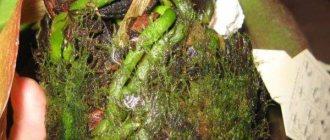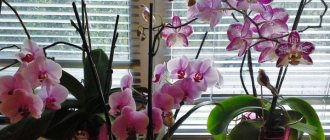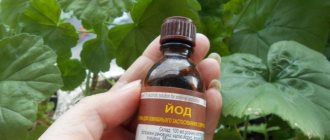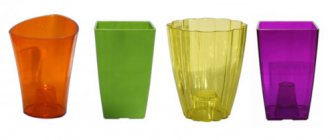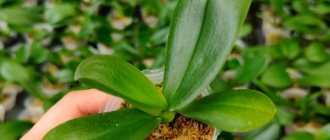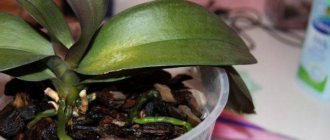Varieties
Several types of moss are used for planting orchids. In total, there are 3 varieties that are most suitable for this matter. It is recommended to switch to using moss after training on tree bark.
Sphagnum
Orchid moss is very common in nature. Grows in forests and wetlands. It is easy to assemble and handle. If necessary, you can purchase a ready-made version at a specialized flower shop.
Reindeer moss
Resin moss is an alternative to sphagnum moss. It is also called reindeer moss. You can also assemble and prepare it yourself or purchase it ready-made in a store. Although it crumbles, many gardeners use reindeer moss as a drainage layer within other moss.
Kukushkin flax
Kukushkin flax is a soil component that grows in the forest. Quite often it grows in the same place with sphagnum, which allows you to alternate them. Can be used as a main substrate or instead of an additive.
What it is?
Moss is a creeping (less often erect) plant that does not have roots or flowers . Grows in damp places:
- wet ground;
- rotting tree trunks;
- stones near the water.
The etymology of the word “moss” comes from the Greek “sphagnum”, i.e. "sponge". According to the scheme of action, this plant really resembles a sponge. It can absorb 20 times its own weight in water! Then the moisture is gradually given to those plants that grow on the moss. It would seem that for orchids that love high humidity, there is nothing better.
Functions of moss:
- active absorption of water;
- maintaining moisture for several days;
- uniform soil moisture (moss covers it completely);
- protecting plant roots from rotting (thanks to the substance sphagnol contained in moss, which has antibacterial properties).
Procurement rules
If you plan to collect soil for plants yourself, then you should choose moss that forms a peat cushion. Carefully remove only the top layer, leaving the lower part untouched. It is in the upper part that all the nutritional components necessary for plant growth are located.
Collection or purchase
If you plan to use sphagnum, it is best to prepare it yourself, which will allow you to be confident in its quality. The same applies to cuckoo flax. But with reindeer moss everything is more complicated; you will have to look for it for a long time, since it does not grow everywhere. It is best to buy in a store.
Processing and disinfection
Collected moss for orchids from the forest needs to be pre-treated against insects. To do this, it is soaked for 12 hours, treated with Akarin, and then kept for another 14 days. Only after this can it be dried. The easiest way is to pour boiling water for 5 minutes, squeeze, and dry.
Drying
Typically, the components of the future soil are dried in the sun. Sphagnum moss is collected in small bunches and then hung on a rope. Alternatively, it is not recommended to use an oven or tumble dryer as complete drying cannot be achieved this way.
Types of moss that are used in growing orchids
There are several varieties of moss that are, to one degree or another, suitable for use in growing orchids:
| Variety of moss | Description | Advantages and disadvantages |
| Sphagnum moss (sphagnum) | A genus that includes several species of bog moss that do not have rhizoids (“roots”). Consists of repeatedly dissected succulent stems with sessile ligulate leaves. It is found in swamps, where it covers hummocks with a loose green mat or floats freely on the surface of the water. | It has very high hygroscopicity, absorbing water over the entire surface with the help of special water-storing cells. Contains an antiseptic (carbolic acid) that kills pathogenic flora. Disadvantages – it acidifies the substrate, when crushed it strongly cakes and becomes compacted. |
| Forest moss (mnium, climatium, ptilium, etc.) | Different types of leaf-stemmed mosses, independently collected by flower growers in the forest. They are used live, collected together with rhizoids. | They create a living, moderately humid environment around orchids if they are placed on top of the substrate. The stems do not become compacted and retain good air permeability. Ideal for cuttings and growing babies in clean moss. Disadvantages: live moss requires careful preliminary preparation; when mixed with bark, it quickly dies and loses its benefits. |
| Kukushkin flax | Polytrichous leaf-stem moss with long (15-40 cm) rigid stems and weak rhizoids. Found in taiga forests and damp meadows. | It does not rot for a long time, maintaining the breathability of the substrate. Disadvantages: too coarse leaves and stems do not absorb water well. |
| Chilean and New Zealand mosses | Tropical varieties of sphagnum mosses. Leafy, without rhizoids. They are distinguished by their long stem length. | Considered ideal for use under orchids in any way. The stems do not crumble when dry, the moss does not become compacted or caked, and even after compaction it retains high breathability. Excellent absorption and retention of water. Disadvantage: Difficult to purchase. |
Due to their availability, the first two varieties of mosses are more often used in Russia - ordinary bog sphagnum and forest leafy mosses. But collectors who have many specimens of orchids of different ages and types prefer to order Chilean or New Zealand sphagnums.
Tip #1. Kukushkin flax, unlike other mosses, is extremely rarely used by orchid growers. It does not cope well with the task common to mosses. However, if you need to loosen fine-grained soil, you can add 4-5 long stems of cuckoo flax to the pot.
Stem length is an important characteristic of moss. Short-stemmed varieties are more susceptible to compaction than long-stemmed varieties.
Features of use
If you plan to use reindeer moss or sphagnum, let's figure out how to use it correctly. Such material can be added to the main soil in certain proportions or used as an independent substrate. The proportions, for example, can be 2:1:5, where the ingredients are moss, charcoal, pine chips.
Use in soil composition
The crushed material is added to the soil during planting, replanting, or when propagating the plant. Experienced gardeners recommend pre-treating with mineral fertilizers.
As a mulching material
Crushed sphagnum is added to the soil composition as one of the components. Pre-treated with mineral fertilizers and crushed. In the future, it is allowed to pour it under the root system.
For plant reanimation
A common problem for novice gardeners is the rotting root system of orchids. Moss is used for resuscitation. To do this, a plant is planted in a container with sphagnum and greenhouse conditions are created.
For raising children
For these purposes, moss is placed in a container and moistened well. After this, the peduncle is cut off and treated with cytokinin paste. After some time, the first shoots will begin to appear from the dormant buds.
Mixture with soil for orchids
A live or dried amendment is used as part of a fertilized soil mixture. This additive improves the drainage properties of the soil. A special substrate is prepared according to a simple recipe:
- the dry additive is first poured with boiling water;
- wipe the plant, trying not to damage its structure;
- freeze the plant;
- After 12 hours in the freezer, dry the additive.
After cleaning, the plant is fertilized (mineral supplements are used) and dried again. The use of the mixture allows you not only to regulate the moisture level, but also to fertilize the soil while watering orchids. Mineral additives last much less in the soil.
Composition of the nutrient substrate
The soil for orchids contains not only sphagnum, but also additional nutritional components. Using the supplement in combination with other nutritional mixtures is more effective. Fern leaves, pine bark and coal are added to the soil (it is better to choose a wood additive).
Reviews from flower growers
Tatyana, 42 years old, Moscow
I have been growing orchids for several years now. I use moss as the main component, sometimes adding it to the soil. I recently started using it as mulch. The first time was unusual. Now I understand how convenient it is.
Catherine. 30 years old, Ufa
For a long time I grew orchids on pine bark. A friend recommended sphagnum. If used correctly, there will be no problems.
Chilean and New Zealand moss in Japanese orchid planting techniques
Having Chilean or New Zealand sphagnum at your disposal, you can practice alternative techniques for growing orchids - “bonsai” or “on a hummock”:
- "Bonsai". A large granite stone is taken and wrapped in moss stems. An orchid is placed on the top of the stone, the roots are distributed along the side surfaces. The plant is secured with wire, and the root system is additionally wrapped in moss.
- "On a hummock." The plastic basket is turned upside down and wrapped with long-stemmed moss. An orchid is planted on top, secured and wrapped with another layer of moss. Everything is carefully removed from the basket and placed in a low pot so that a mound is formed with an orchid on top.
Orchids planted using these methods can only be watered by spraying. New Zealand and Chilean sphagnums collect and hold water well, so no soaking or watering is required.
Miniature varieties of orchids - mini-phalaenopsis or neophynetia - are suitable for growing according to the Japanese method.
Why do orchids need moss?
An orchid of tropical origin is an epiphytic plant with a special root system. It does not need soil, since it is able to attach itself to other plants or trees without using their juices and nutrients. Growing widely, the roots absorb moisture from the air, and under the influence of light the process of photosynthesis takes place in them.
Consequently, the substrate for orchids is needed mainly so that the flower can be fixed and held in a certain place, and not for feeding the plant. Based on this, experienced gardeners believe that moss is one of the best substrates or components for orchids.
In addition, moss performs other functions:
- Absorbs and retains moisture well. Due to its structure, moss absorbs 20 times more water than its own weight. Thus, it helps the orchid cope with excessive watering.
- Wet moss is always green, but as it dries it becomes lighter, so you can visually determine the moisture level of the substrate and water it in a timely manner.
- After the moss dies, it turns into peat, which serves as food for the orchid.
- It does not rot, as it contains antiseptic substances, thanks to which the entire substrate in the pot is disinfected.
- The antibacterial and antiseptic properties of moss protect the flower from various diseases that arise as a result of waterlogging of the substrate.
- The plant makes the soil looser and lighter.
- Has an attractive appearance.
